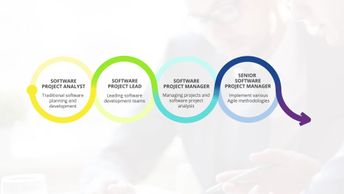Final Exam: Senior Software Project Manager - apply guidelines and best practices to create an effective job description to attract the best talent
- compare and contrast the Value Management Office (VMO) with the Project Management Office (PMO)
- compare traditional projects to Agile projects
- define the spring backlog and how to use it in day-to-day operations
- demonstrate how risk or anti-value is estimated and incorporated into the product backlog
- demonstrate the Shu-Ha-Ri method of knowledge gaining and describe factors that influence project tailoring
- describe Agile leadership best practices with regards to people, product, and process
- describe Agile risk management and how to apply it to the Agile process
- describe Disciplined Agile Delivery and its benefits
- describe growth, efficiency, and financial types of values that drive value-based management
- describe how a data strategy aligns the organization's data-related activities towards providing Business Intelligence insights
- describe how to manage the sprint backlog
- describe how to run an effective sprint review meeting
- describe methods to manage the product backlog effectively
- describe techniques and frameworks for scaling Agile projects
- describe techniques for estimating Agile story points and involving the Agile team in the decision-making process
- describe the benefits of using simple, tactile tools and the problems with high-tech tools
- describe the characteristics of various project management methodologies
- describe the daily Scrum and how to use it in the Agile process effectively
- describe the importance of aligning SMART business objectives to organizational strategic goals
- describe the Large Scale Scrum framework and its benefits
- describe the leadership focus of Agile projects
- describe the process involved in defining the strategic goals and aligning the organizational activities to achieve the set goals
- describe the purpose of the product backlog and how it applies to the Agile process
- discover Advanced Analytics as an effective tool for Business Intelligence-related data analysis
- discover commonly used Business Intelligence applications to analyze and report information
- discover how making sound ethical business decisions adds value for an organization
- discover how managing a multicultural, diverse team adds value for internal stakeholders of an organization
- discover techniques to become an effective Product Owner
- discover techniques to become an effective Scrum Master
- discover the critical skills required for a software developer and a software project manager, two key software project team members
- discover the LeSS framework for scaling Scrum
- discover the Scrum of Scrums framework for scaling Scrum
- discover the steps involved in planning for Business Intelligence across the organization
- discover the value drives for a value-based organization
- establish vision and mission statements that will motivate the organization to achieve set strategic goals
- identify measure of progress
- identify the key steps involved in evaluating a candidate for a software developer role in the software project team
- identify the roles and responsibilities of key team members within a software project team
- identify the various sources from where talent can be recruited for a software project team
- recall how work is prioritized
- recall the tools and techniques used to create a shared product vision
- recall the V, Spiral, and Iterative traditional-agile hybrid models
- recognize how a hybrid may be utilized as a team is transitioning to Agile
- recognize how to evaluate the communication skills of a candidate to determine the right fit for a software developer role
- recognize practices to adopt for driving a data-driven mindset within an organization
- recognize practices to improve the business insights of reports
- recognize situations where hybrid methodologies may be necessary
- recognize the assessment tool that predicts the suitability of a project to use Agile, Traditional, or Hybrid approaches
- recognize the best practices involved in establishing SMART business objectives
- recognize the best practices to be adopted for developing self-organizing teams
- recognize the commonly used approaches to establish the organizational strategic goals
- recognize the considerations to keep in mind when defining the KPIs for Business Intelligence-related data analysis
- recognize the guidelines to follow while performing a SWOT analysis on the organization's current business environment
- recognize the importance of value in business strategy
- recognize the key challenges faced when recruiting key talent for a software project
- recognize the opportunity to adapt the plan to welcome change, address risks, and leverage opportunities
- recognize the role of collaboration between team members in Scrum
- recognize the various types of waste (Muda) and how they are related to value delivery
- recognize the ways to overcome common challenges in scaling scrum
|


